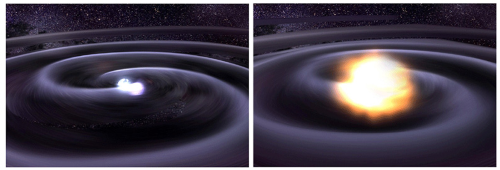Tag archives: black hole
LIGO bags another black-hole merger

The other ones: five observed black-hole mergers, plus a possible merger shown with dashed outlines (Courtesy: LIGO)
By Hamish Johnston
They have done it again. Physicists working on the LIGO gravitational-wave detectors in the US have announced the observation of another black-hole merger.
This event was spotted on 8 June 2017 and involved two black holes combining to form a black hole 18 times more massive than the Sun. The Virgo detector in Italy did not see the event because it was not switched on. This is the fifth observation of gravitational waves from merging black holes seen by LIGO, which along with Virgo also detected a signal in August from the merger of two neutron stars. Unlike the neutron-star event, no electromagnetic radiation was seen from the merger.
View all posts by this author | View this author's profile
In flight around the world’s brightest laser and the inverse Cheerio effect
By Tushna Commissariat
If you have never been one of the lucky few to have wandered the tunnels of a particle accelerator, but have always wondered what lies within, take a look at the video above. The European X-ray Free Electron Laser (European XFEL) – which is currently under construction in Germany and will come online next year – will provide ultrashort (27,000 X-ray flashes per second) and ultrabright X-ray laser flashes that are needed to study chemical reactions in situ or to study extreme states of matter (you can read more about the kind of research that will be done there in the September issue of Physics World magazine). The XFEL tunnel is 3.4 km long and you can zoom across all of it in the 5 minute long video. I particularly enjoyed watching particular locations where engineers could be seen carrying out tests, as well as watching folks on bicycles wobble out of the camera’s way.
On a slightly related note, if, like me, you occasionally get a bit muddled when it comes to certain details of different particle accelerators – for example which came first, the synchrotron or the cyclotron – take a look at this excellent “primer” over at Symmetry magazine.
View all posts by this author | View this author's profile
George Smoot on mapping the universe with gravity

Measuring the universe: George Smoot enthuses about gravitational waves.
By Hamish Johnston at the Lindau Nobel Laureate Meeting in Germany
Yesterday I was in a fantastic session with George Smoot, who shared the 2006 Nobel Prize for Physics for discovering the anisotropy in the cosmic microwave background. He will be speaking today at the 66th Lindau Nobel Laureate Meeting about another important astronomical discovery, the first direct detection of gravitational waves that was made by LIGO in September 2015. Waves that were created by the merger of two unexpectedly large black holes.
Second wave: all about LIGO, black holes, gravitational ripples and more
By Tushna Commissariat
What an exciting week it has been, as the LIGO and Virgo collaborations announced that they have definitely detected a second gravitational wave event using the Advanced Laser Interferometer Gravitational-wave Observatory (aLIGO) in the US. These waves made their way into aLIGO early on Boxing Day last year (in fact it was still very late on Christmas Day in the US states where the twin detectors are located), a mere three months after the first gravitational-wave event was detected on 14 September 2015.
This event once again involved the collision and merger of two stellar-mass black holes, and since the “Boxing Day binary” is still on my mind, this week’s Red Folder is a collection of all the lovely images, videos, infographics and learning tools that have emerged since Wednesday.
LIGO physicist and comic artist Nutsinee Kijbunchoo has drawn a cartoon showing that while the researchers were excited about the swift second wave, they were a bit spoilt by the first, which was loud and clear – and could be seen by naked eye in the data. The black holes involved in the latest wave were smaller and a bit further away, meaning the signal was fainter, but actually lasted for longer in the detectors.
View all posts by this author | View this author's profile
LIGO paints a clearer picture of its merging black holes

Illustration of two black holes spiralling into each other to create a larger black hole. (Courtesy: Caltech/MIT/LIGO Lab)
By Hamish Johnston
Physicists working on the LIGO gravitational-wave detectors have released more information about the merging black holes that they announced the discovery of earlier this year. Dubbed GW150914, we now know that the gravitational wave was created by the merger of one black hole that was 36 times as massive as the Sun with a smaller black hole that weighed in at 29 solar masses. The result of the merger was a black hole at 62 solar masses and a spin angular momentum of 0.67, where 1.0 is the maximum value of spin a black hole can have.
View all posts by this author | View this author's profile
HAWC spots TeV gamma ray flare

Now you see it, now you don’t: a TeV gamma-ray flare spotted by HAWC. (Courtesy: Michelle Hui)
By Hamish Johnston at the APS April Meeting in Salt Lake City
Talk about luck. Just 10 days before the April Meeting the High-Altitude Water Cherenkov (HAWC) gamma-ray observatory lit up with the detection of a galaxy that produced large numbers of teraelectronvolt (TeV) gamma rays for just one day (see image).
Dubbed Markarian 501, HAWC astrophysicists believe that the flare could be driven by a supermassive black hole at the centre of the galaxy. However, they admit that they don’t really understand how such flares occur.
View all posts by this author | View this author's profile
Soft hair on black holes, making concrete on Mars and exploring the cosmos in 2016
By Hamish Johnston
This week’s Red Folder looks to the cosmos, starting with a spiffy new video from the European Space Agency. The slick presentation is a preview of some of the extra-terrestrial exploits that the agency has planned for 2016. This includes the landing of the Schiaparelli probe on the surface of Mars. This stationery lander will survey its Martian environs to find a suitable location to drop the ExoMars rover in 2018. The mission’s namesake is the Italian astronomer Giovanni Schiaparelli, who mapped the surface of Mars and was the first to use the term canali to describe the straight lines that were thought to exist on the surface of the planet.
It’s possible that someday humans will colonize Mars and this will involve building dwellings and other structures on the Red Planet. In preparation, Lin Wan, Roman Wendner and Gianluca Cusatis at Northwestern University in the US have come up with a recipe for making concrete on Mars. The trio reckon that any successful colonization of the Red Planet will have to rely on local building materials because shipping stuff from Earth would be horrendously expensive.
First image of a black hole expected a year from now
By Louise Mayor in Waterloo, Canada
According to Avery Broderick, a physicist at the University of Waterloo and the Perimeter Institute for Theoretical Physics (PI) in Canada, the iconic picture of a black hole from the film Interstellar “really only presages astronomical reality by about a year”. That’s because, as Broderick explains, “as soon as next spring the Event Horizon Telescope is gonna produce images of the black hole at the centre of the Milky Way”.
What do strange metals and black holes have in common?

Subir Sachdev.
By Hamish Johnston in Waterloo, Canada
Harvard’s Subir Sachdev has just taken the audience here at the Convergence conference on a delightful romp through the phase diagram of the cuprate high-temperature superconductors. What I found most interesting was not the superconducting phase, but rather Sachdev’s description of the “strange metal” phase.
This phase occurs when the cuprate copper-oxide layer is highly doped with holes and has perplexed physicists for some time – hence its strange moniker. It has no quasiparticles and lots of low-energy excitations so there is no easy way to describe the collective behaviour of the electrons.
The Dark Matter Garden, gravitational atoms, boys and girls with toys, and more

Gravitational gardening: the Dark Matter Garden at this year’s RHS Chelsea Flower Show. (Courtesy: National Schools’ Observatory)
By Hamish Johnston
Gardening is something that the British take very seriously and this week’s RHS Chelsea Flower Show is the pinnacle of that obsession. Indeed, it is so popular that it is covered live on television by the BBC. One highlight of the show is the garden competition, in which designers transform an empty plot into a dazzling garden in just 10 days. This year’s entries include the Dark Matter Garden, which “brings the mysteries of the universe to Chelsea”. That’s the claim of the designers of the garden (including several astronomers), who built it for the UK’s National Schools’ Observatory. The team says that its gold-medal-winning design includes “innovative structures and planting, and represents the effect of dark matter on light”.
